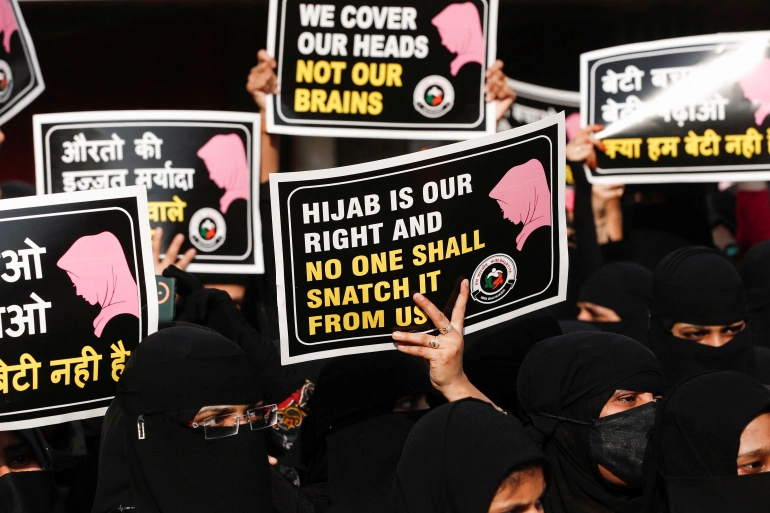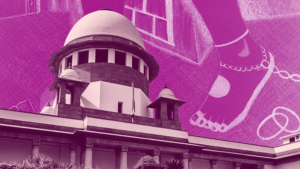Three Lessons On Equality From Supreme Court’s Hijab Verdict

On October 13, the Supreme Court of India passed its judgement on the hijab ban in educational institutions imposed by the Karnataka Government. The two-judge bench gave a divided opinion on the constitutional validity of the ban. While Justice Sudhanshu Dhulia struck down the ban terming it an ‘attack on dignity’ and an ‘invasion of privacy’, Justice Hemant Gupta upheld its validity, describing uniforms as a ‘reinforcer of equality under Article 14’.
In this analysis, we discuss the three lessons on equality we draw from this case.
Lesson 1: Binaries Are Limiting
Under Article 25 of the Indian Constitution, all persons are equally entitled to freedom of conscience and the right to freely profess, practise and propagate religion. But not every religious practice is protected under this article. The state is allowed to interfere in practices that may be associated with a religion but are secular in nature and are not essential religious practices.
The article is also subject to public order, morality, health, and other fundamental rights provided under part-III of the Constitution. Article 25(2) also provides that the right to freedom of religion shall not prevent the state from taking social welfare and reform measures.
To establish the right to freedom of religion, Indian courts have over the years developed a test called the essential religious test or the ERP. It involves proving that the practice is a foundational practice without which the religion would not remain the same.
In this case, the petitioners argued that wearing of hijab is part of their essential religious practice and thus a ban on it is a violation of their right to religion whereas the government lawyers argued that the compulsive dress code cannot be held as an essential religious practice in Islam.
Women’s Agency Is Complex
This gives rise to the feminist question: how do you determine essentiality, and based on whose belief? That of the community or the individual? If the State is allowed to interfere for the “reform” of a religion, then whose voices should be centred? The ERP test invariably centres the voices of religious patriarchs who are often men, inspired by notions of community honour. The test takes away women’s complex relationship with agency allowing religious patriarchs to be the final arbitrators who decide what is and is not an essential religious practice.
Constitutional law scholar Gautam Bhatia argues that in a rather agency-denying fashion, the ERP test argues that if a practice is an essential to a religion, then a person has no choice but to follow the practice. This ignores the multiple negotiations women make within and outside their religion. Women wear the hijab for multiple reasons — for a sincerely held belief, to assert their right to religion, as a means to negotiate with their families the right to access public spaces.
Constitutional law scholar Megha Mehta points out that from triple talaq to Sabarimala and now the hijab, the voices of women worshippers themselves are often not cited in judgements.
In the hijab case, both the Karnataka High Court and the Supreme Court (speaking through Justice Gupta) fell into this binary of agency-force, religion-equality. Thus, Justice Gupta held that if the women are not allowed to enter their classrooms, it is the result of their voluntary action of not wearing the uniform. He said:
“The State has not denied admission to the students from attending classes. If they choose not to attend classes due to the uniform that has been prescribed, it is a voluntary act of such students and cannot be said to be in violation of Article 29 by the State. It is not a denial of rights by the State but a voluntary act of the students. It would thus not amount to denial of [the] right to education if a student, by choice, does not attend the school.”
Justice Dhulia however attempts to move away from the binary in two ways. First, he holds that the ERP test is only applicable to the rights of a community or a sect and State interference with it. In the case of individual rights, as in the current case, the ERP test is ‘not at all relevant’. He held that if a belief is sincerely held, and it harms no one else, then there can be no justifiable reason for banning it – in this case, the wearing of a hijab in the classroom.
This view potentially recognises women’s relationship with religion beyond the narratives of adversary and victimhood. Instead it creates room for their voices in the debate by asking them what their sincerely held beliefs are. He also warned courts against being quick in deciding questions of theology as these are always more than one viewpoint and courts are not equipped enough to decide which voice should prevail.
Second, he declared that the question the court should ask is if the government order was proportional. It is by asking this question that he concluded that asking a schoolgirl to remove her hijab at her school gate so that she can attend the class is an invasion of her privacy and dignity. He locates women’s lived reality by declaring that the case has to be seen from the perspective of the challenges already faced by a girl child in accessing education. He wrote:
“The question this Court would therefore put before itself is also whether we are making the life of a girl child any better by denying her education, merely because she wears a hijab!”
The judgement of Justice Dhulia thus recognises the complex terrain of negotiations and bargains, where women’s beliefs and socio-economic hurdles are also heard.
And this is the first lesson of the case: to centre the voices of women beyond the easy binaries of agency and force, religion and equality.
Lesson 2: Neutral Can Be Discriminatory Too
Irrespective of whether the wearing of the hijab is an essential religious practice or not, the core of the matter is discrimination. Under Article 15 of the Indian Constitution, a provision that barely gets mentioned under the judgment, any discrimination on the ground of religion and sex is prohibited. Denial of education to Muslim women for wearing the hijab is essentially a matter of discrimination, whatever the reason for wearing it. It amounts to intersectional discrimination because Muslim women are being denied their right to education for both their gender and religious identity.
The Karnataka High Court held that the complaint of discrimination under Article 14 and 15 is not acceptable when the dress code is equally applicable to all the students, regardless of religion, language, gender etc. Thus the court held that the uniform can exclude any other apparel like the bhagwa or blue shawl that may have visible religious overtones. In short, the High Court accepted the argument of government lawyers that the government order is ‘religiously neutral’ and ‘universally applicable’. Justice Gupta reasoned similarly.
However, the above assertion is not true. As Justice Dhulia pointed out the government order is specifically addressed to the hijab, terming it as ‘an obstacle to unity and uniformity’ in schools and colleges and against ‘the larger interest of unity, equality and public order’. Also, even if the government argument on neutrality is accepted, this by itself does not mean that the provision is not discriminatory. A provision that does not mention any particular group may still be discriminatory if the impact of the proposal is such that a particular group disproportionately bears the brunt of it. This is called indirect discrimination.
For instance, consider the facts of the case Rajbala v. State of Haryana case. A condition for fighting Panchayat elections is that all candidates should have passed Class 8 exams. This policy on the face of it is a neutral condition. But given the historical and socio-economic denial of education to women and SC/ST communities, this condition will bar more women and members of the SC/ST community than upper caste men from fighting panchayat elections. This provision ends up disproportionately harming one group more than the other even though the policy seems neutral.
Indirect discrimination still puts a group at a disadvantage, and if this is not recognised it could perpetuate structural inequalities. In Nitisha v. UOI, the Supreme Court held that under the constitutional vision of equality, both direct and indirect discrimination have to be systemically evaluated.
Impacts Not Recognised
On February 5, 2022, the Karnataka government passed an order requiring education institutions to enforce a ‘suitable code of conduct’ in institutions and ‘provide standardised learning experience’.
The impact on Muslim women was almost instant. Those wearing the hijab were denied entry into classes, some were suspended from school. A few teachers too were suspended for allowing veiled Muslim women students into classes. Some students were forced to altogether drop out of their institutions.
On March 15, the Karnataka High Court judgement upheld the ban. Immediately afterwards, the Minister of Primary and Secondary Education B C Nagesh declared that students wearing the hijab would not be allowed to write exams. Muslim women students are stoped from writing critical board exams for Classes 10 and 12. This also happened in exams to professional courses. Similar incidents were also reported from other states. In a short span of time, the education and careers of Muslim women were subject to long term impacts. In Udupi alone, around 230 Muslim girls missed classes and examinations in the first month after the ban was imposed, data show.
But Both Karnataka HC and Justice Gupta failed to even acknowledge these multiple incidents in their judgments. Currently, the judgement of the Karnataka High Court stands and the hijab ban continues. Even now, women are being deprived of their right to education.
This is the second lesson of the judgment: a provision that seems neutral can be discriminatory in its implications.
Lesson 3: Uniformity Does Not Guarantee Equality
The government order was challenged on the grounds of violation of Articles 14, 15, 19, and 21. But the entirety of the constitutional challenge is reduced to a fiat by the simple assertion of uniformity. This is because the entire judgement of J. Gupta and the Karnataka High Court is marked by the fear of difference. The judge noted:
“….some students wearing headscarf in a secular school run by the State Government would stand out and overtly appear differently.….Apparent distinction of some of the students wearing headscarf would not form a homogenous group of students in a school where education is to be imparted homogeneously and equally, irrespective of any religious identification mark….The homogeneity amongst the students in the matter of uniform would prepare them to grow without any distinction on the basis of religious symbol”.
This statement implies that any overt difference has to be hidden away, invisibilised so that all can appear ‘homogeneous’ and thus ‘equal’. The judge is of the view that uniforms ‘treat all students alike’ and thus the ban is in furtherance of the right to equality under Article 14. But the idea of treating everyone alike is only a limited or formal notion of equality. Sometimes treating everyone alike may actually produce more inequality.
There is growing recognition in Indian courts that substantial equality is the deeper notion of equality. Unlike, formal equality which is merely asserted in texts, or abstract, the substantial notion of equality looks at the structural reasons behind discrimination. Substantial equality requires active actions to be taken to ensure that structurally disadvantaged groups are ensured equality of opportunity. In the current case, Justice Gupta has confused uniformity with equality.
Further, Justice Gupta’s limited focus on uniformity — wherein everyone is expected to ‘transcend their group identity’ can easily manifest as an assertion of majoritarianism. Majoritarian ways of being can easily become ‘part of common culture’ and hence, uniform and acceptable. This may lead to a demand for forceful assimilation, instead of full-recognition, of the fundamental rights of a minority community. This is the second reason to move beyond formal equality so that the dominant norm does not become a standard everyone has to strive for.
This is the third lesson: uniformity does not guarantee equality because that demands the removal of the structural barriers faced by disadvantaged groups.
We believe everyone deserves equal access to accurate news. Support from our readers enables us to keep our journalism open and free for everyone, all over the world.




